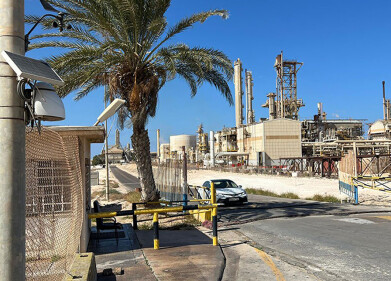Air Quality Monitoring
Air Monitoring in the UK, the Next 5 years
Feb 07 2024
It is estimated that around 28,000 to 36,000 people die every year in the UK as a result of human-made air pollution, and Public Health England has described air pollution as the largest environmental risk to the public’s health. The WHO estimates 7 million people die prematurely from exposure to air pollution every year and says: Air quality monitoring is the first step for understanding a population’s exposure and taking action.
The UK seeks to improve air quality through the monitoring and management of both emissions and concentrations. While the two are closely linked, concentrations are also affected by emissions from neighbouring countries, natural sources, and weather patterns. Monitoring is therefore essential not just to ensure regulatory compliance, but also for source attribution.
Emission to air
Industrial emissions are tightly regulated with emission limits being regularly lowered. At the same time, measurement technologies are improving, enabling regulators to lower limits and introduce more process-specific monitoring requirements. As more governments and businesses commit to Net Zero targets, there is a growing commitment to the monitoring and reduction of greenhouse gas (GHG) emissions. As a powerful GHG, particular attention is being applied to the measurement of methane emissions, and there is also a growing requirement to be able to measure the effectiveness and efficiency of carbon capture processes.
The National Emission Ceilings Regulations 2018 have legally-binding emission reduction commitments to reduce the amount of 5 key pollutants released into the air each year, compared to a 2005 baseline. The 5 pollutants are:
1. Fine particulate matter (PM2.5)
2. Oxides of nitrogen (NOx)
3. Sulphur dioxide (SO2)
4. Ammonia (NH3)
5. Non-methane volatile organic compounds
In 2021, the UK was compliant with emission reduction commitments for 4 of the 5 key pollutants, except for PM2.5. The UK also has legally-binding emission reduction commitments for these 5 pollutants for 2030, and the delivery of this objective is outlined in the (25 year) Environmental Improvement Plan, which has the following goals;
- cut overall air pollution by tackling the key sources of emissions, including reducing the maximum limits for domestic burning appliances in Smoke Control Areas
- tackle specific hotspots by challenging councils to improve air quality more quickly, while supporting them with clear guidance, funding, and tools
- reduce ammonia emissions (crucial for sensitive natural habitats) by using incentives in farming schemes.
Ambient air quality
In the UK, most action will be directed towards the 3 pollutants which have the majority of impact - fine particulate matter (PM2.5), nitrogen oxides and ammonia.
PM2.5 is either emitted directly from sources, known as primary PM2.5, or formed in the air from chemical reactions between other pollutants, known as secondary PM2.5. Primary PM2.5 is emitted from human activities, like burning fuels, braking and various industrial processes, as well as from natural sources like sea spray and dust. Domestic combustion contributed 27% of emissions in 2021 and industrial combustion of biomass fuels accounts for 18%.
The Environment Act 2021 set 2 new legally-binding long-term targets to reduce concentrations of fine particulate matter, PM2.5. The two new targets are an annual mean concentration of 10 μg/m3 or below and a reduction in average population exposure by 35% by 2040, compared to a 2018 baseline. The management of PM2.5 levels is however complicated by the fact that around half of it is derived from natural and transboundary sources.
In 2022, the WHO set new guidelines for annual mean values: the PM2.5 guideline was halved to an annual average 5 µg/m3, and a 24-hour average 15 µg/m3. PM10 was decreased by 25 %, and nitrogen dioxide (NO2) was set at four times lower than the previous guideline.
Historically, air quality in the UK has been monitored by networks of reference standard air quality monitoring stations, which are very accurate, but large, fixed in one location and very expensive to install and run. In recent years, numerous companies have developed low-cost air quality sensors that are small and operate on low power. The accuracy of these sensors has gradually improved, and with performance verification schemes such as MCERTS, it is now possible to install networks of small sensors to help identify pollution hot-spots, to better measure the effects of mitigation measures and to provide the Public with easy access to air quality data.
The rapid expansion in the use of smaller, lower cost sensors provides greater opportunities for air quality improvements. These advantages are:
1. Lower cost, so multiple measurement points possible.
2. Networks of sensors enable source attribution.
3. Low power and easy to install, so measurement location is very flexible.
4. Continuous measurements are superior to monthly averages from passive diffusion tubes.
Last year, the Environment Audit Committee conducted an inquiry to establish the adequacy of current measures to promote indoor and outdoor air quality, and to assess whether air quality targets are sufficient for protecting public health and the environment. Evidence has been provided from a wide variety of eminent sources and the report should be available soon.
Air quality has a much higher profile than ever before and both regulations and funding are in place to drive improvements, so there will be increased investment in monitoring technologies so that improvements can be implemented and measured. Such improvements will include measures such as clean air zones, traffic management, public/sustainable transport, urban design, behavioural change, transport electrification etc.
Indoor air quality (IAQ)
Most people spend around 80% of their time indoors, so IAQ can have the greatest health effects, and this is now the focus of increased attention.
Many of the key outdoor pollutants are important indoors, including PM2.5, NOx and carbon monoxide. However, key IAQ factors also include mould and damp which can lead to elevated concentrations of biological aerosols. The indoor environment can also accumulate much higher concentrations of VOCs due to their release from construction and furnishing materials and the use of cleaning and personal care products.
The COVID outbreak highlighted the need for effective ventilation, but this potentially conflicts with the requirement for buildings to be energy efficient. There is therefore a strong demand for engineering solutions that enable ventilation and energy efficiency simultaneously. From a monitoring perspective, carbon dioxide is commonly regarded as a key factor in determining adequate levels of ventilation.
The future of monitoring
Technology and regulatory developments in the monitoring of both air and water follow a similar trajectory. In both sectors, sensors are becoming smarter, smaller, more accurate, more precise, less power hungry and offer longer intervals between calibration or service. Increasingly, data are being transmitted to the Cloud with web-enabled access delivering easy access to insightful information 24/7.
These trends mean (a) that monitoring can be continuous (b) the spatial density of monitoring points can be increased, and (c) the cost of data is reduced but the value is increased.
Digital Edition
AET 28.4 Oct/Nov 2024
November 2024
Gas Detection - Go from lagging to leading: why investment in gas detection makes sense Air Monitoring - Swirl and vortex meters will aid green hydrogen production - Beyond the Stack: Emi...
View all digital editions
Events
Jan 12 2025 Abu Dhabi, UAE
Jan 14 2025 Abu Dhabi, UAE
Jan 20 2025 San Diego, CA, USA
Carrefour des Gestions Locales de L'eau
Jan 22 2025 Rennes, France
Safety, Health & Wellbeing LIVE
Jan 22 2025 Manchester, UK



















